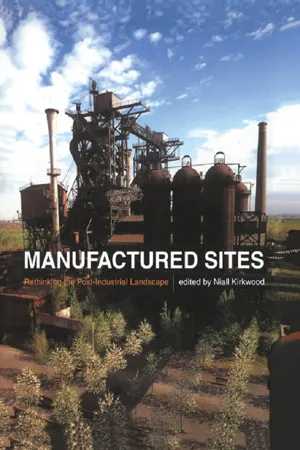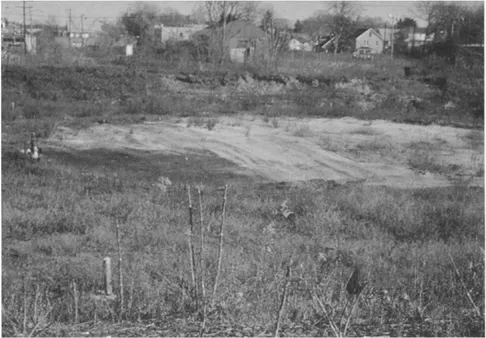![]()
Part I
Introduction
Part I introduces manufactured sites and provides an overview to the reclamation of waste and contaminated urban sites. It also serves as an introduction to the subject matter of the essays and responses that follow in Parts II and III.
In the first essay of Part I, an overview of manufactured sites is presented, along with recent academic, professional and industry concerns in this area. Three definitions of the term “manufactured sites” are introduced that address the conditions of these contaminated urban sites. Two central themes are introduced: the range of emerging technologies and design strategies used in reclaiming waste and contaminated urban sites, and the promising and creative alliances of technology and design that result.
Rosanna Sattler and David Li, experienced and nationally respected environmental lawyers, have been closely involved in the development and review of legislation and litigation surrounding manufactured sites and environmental contamination. In the second essay, assisted by their colleagues Deborah DiVerdi Carlson and John S.Day, they lay out the legal and regulatory concerns of manufactured sites. These concentrate on environmental law and the magnitude and uncertainty of environmental liability risks and costs. Although focused primarily on the United States, mention is also made of similar laws in Europe and the United Kingdom. Sattler and Li present and reinforce the role of environmental lawyers as playing prominent and active roles as members of multidisciplinary environmental and design teams.
![]()
Niall Kirkwood
Virtually every city in the nation's older industrial regions, no matter its size, grapples with the challenge of unused manufacturing facilities and other industrial sites… Public concern about health effects from hazardous chemicals, stricter environmental laws, and changing private-sector development priorities have made it increasingly difficult for communities to restore and reuse former manufacturing sites.1
Introduction
What are “manufactured sites”? As Michael Hough states in the Foreword, manufactured sites are related to “emerging efforts to address the legacy of contaminated and derelict lands that have been left by past industrial activity.”
The purpose of the collection of essays in this book is broadly to tackle this question from a range of academic, research and practice viewpoints. The invited authors were selected to expose the reader to innovative environmental, engineering and design approaches to the legacy of contaminated and derelict land, as well as to illustrate ongoing research and built projects of national and international significance. In addition, Manufactured Sites is seen by the editor and authors as contributing to an ongoing dialogue on the interdisciplinary nature of this work that must occur between those disciplines and professionals who are currently engaged on the restoration and reuse of industrial land in our urban landscape.
The phenomena of manufactured sites that follows is focused on five interrelated areas that will appear with varying emphasis in the essays. First, industrial lands, ranging from small factories to vast municipal landfills that are currently undergoing reuse are described. Second, the range of concepts, and implementation strategies of site technologies that clean up contamination on these sites is illustrated. Third, the professional nature of the recycling of industrial urban land is discussed, addressing attitudes to restoration and uses that are often in conflict with current development and land ownership patterns. Fourth, the types of professional practitioners, industries and specialists involved in the remediation and regeneration of manufactured sites are addressed. Finally, models for reclaiming landscapes are explored based on the alliance and interaction of clean-up technologies with progressive landscape design practices.
Where are manufactured sites located?
A derelict three-acre site located next to the Detroit riverfront with locked gates, abandoned machinery and manufacturing wastes and chemical pollutants in the adjacent ground is illustrated in Figure 1.1.
Figure 1.1 Manufactured site, Detroit riverfront, 1999
Thousands of manufactured sites like this are now to be found in other major metropolitan centers. They include factories, scrap-metal yards and railroad corridors, waste transfer stations, vacant corner gas stations and rusting machine shops—a mere listing of these places does little to describe the extent of this industrial legacy nationwide.2 Nor do the sites themselves suggest any single pattern for their future regeneration—they appear initially too haphazard in their nature, size, location and extent of environmental degradation. The pressures for redevelopment are immense, the factors of ownership and contamination are significant, and the visions for a site's reuse are as numerous as there are interested parties.
“Land long polluted”
Reporting on manufactured sites is topical. A 1998 front-page article in The New York Times, subtitled “New Laws and Funds Fuel Revival of Land Long Polluted”3 reported on an emerging industry of financial consultants and environmental scientists that has grown up to attend to the approximately 6,500 “brownfields” in the former manufacturing centers surrounding the city of New York. “Brownfields” are defined here as “abandoned or underused industrial and commercial sites where redevelopment is complicated by real or perceived contamination,”4 but the term is more commonly associated with land that has immediate potential for economic redevelopment. These sites account for “more than 1,300 acres of pollution-stained empty lots or industrial buildings, making up 40 percent of the total of 3,300 acres of tainted sites in the city.” These sites form part of the estimated 500,000 brownfields considered to be present in the United States at this time.5 The article also noted that “The land is desirable for the reasons businesses once favored inner city locations—proximity to transportation and easy access for suppliers and customers.” However, it concludes that “No one involved in rehabilitating old urban sites expects all the scars of a century of heavy industry to be erased.” The continued presence of on-site industrial and chemical wastes, metals, solvents, underground oil tanks and toxic sediments left on-site from industrial activities, renders them problematic for conventional redevelopment strategies in comparison to non-contaminated urban land or rural “greenfield” sites.
In 1998, The New York Times again reported a related topic: the fate of the 3,000 acre Fresh Kills Landfill, the municipal waste site for the New York Boroughs on Staten Island.6 More than three and a half times the size of New York's Central Park, this landfill is slated to be closed by the end of the year 2001 at an estimated cost of $1 billion dollars. Encapsulation and an array of landfill technologies to clean venting gases and to collect leachates were outlined, but the article went on to conclude that “detailed plans have still to be worked out for what to do with the Fresh Kills land.” The City of New York, Department of City Planning (DCP) is now considering a number of paths to provide for end-use proposals, including the mounting of public design competitions. Third, a new natural in situ remediation technology using plants to uptake heavy metals found in contaminated residential soils in Dorchester, Massachusetts was headlined in The Boston Globe in March of 1997 under the title “Plants doing the dirty work in cleanup of toxic waste.”7 The lead contamination in the soils in this case resulted from industrial processes formerly located on an adjacent site.
These three press reports, representative of the growing number throughout the country, draw attention to the derelict and hazardous state of post-industrial land within cities and towns. In addition they record an ever-increasing tendency toward both the need to clean up and redevelop environmentally compromised land.
Reclaiming and recycling
The subject of reclaiming and recycling manufactured sites exerts a special fascination that is not fully explained by the influence it has had on the planning and rebuilding of cities. Even those unconcerned with the daily work of planning, site design and real estate development are now required to take account of this phenomenon. Journalists write about the pressing civic burden of closed landfills, polluted waterways and wetlands, industrial oil spills and abandoned and rusting factory sites. Politicians have taken up the cause of “contaminated urban land” through the growing amount of federal and local state legislation. Community pressure groups were present and vocal from the very beginning. Many groups, whether social, cultural, commercial or political in nature, have laid claim to this disputed area.
Two issues dominate current discussion of these blighted landscapes. First, the remaining pervasive pattern of hazardous substances found in the soils, groundwater and within the fabric of buildings and infrastructure left standing on-site. Second, the motivation to return these manufactured sites to productive use and the physical means by which this can be carried out.
Defining manufactured sites
The term, “manufactured sites” and the title of this book can be understood in three ways. The first refers to a class of site found in older manufacturing cities and towns and whose present condition is a result of manufacturing and industrial processes or disposal of waste. In addition these conditions have now become their identifying and prevailing character. Second, it can signify both the presence of environmentally
Figure 1.2 Former gas manufacturing plant, Connecticut 2000
challenged sites and the relationship to processes and techniques used to clean up these conditions. Third, it presents an interdisciplinary approach to reclaiming sites altered by industrial activity.
“Sites of manufacture”
The first definition, “sites of manufacture,” describes sites whose former activities have included industrial and manufacturing processes. Places synonymous with this environmentally compromised condition are easily recognizable within the blighted city fabric: abandoned mills alongside river corridors and canals, mountainous waste landfills that occupy the city's periphery, chemical and oil refinery facilities, derelict marine terminals, and the patchwork of small factories within older residential communities. Examples of “sites of manufacture” include former tool and die shops, metal fabrication and electroplating factories, textile and paper mills, and former manufactured town gas plants that are found in abundance throughout older cities.
Figure 1.2 illustrates the site of a former manufactured town gas plant in a Connecticut city. The circular outline on the ground in the middle of the image denotes the location of the former cylindrical structure of the gas tank holder. Coal tars, including benzene and phenols, as well as metals and cyanides from the town gas manufacturing process, are likely to be found in the surrounding soils and groundwater. In this case, the term, “sites of manufacture” is used to identify and classify land—particularly if, as is often the case, it occupies prime locations within the urban fabric and is currently sought after fo...


